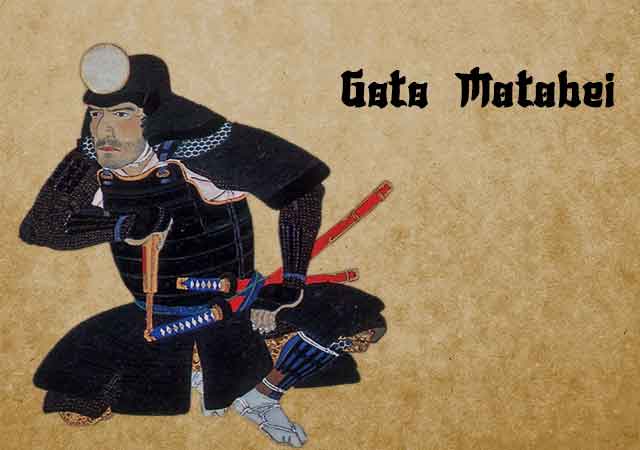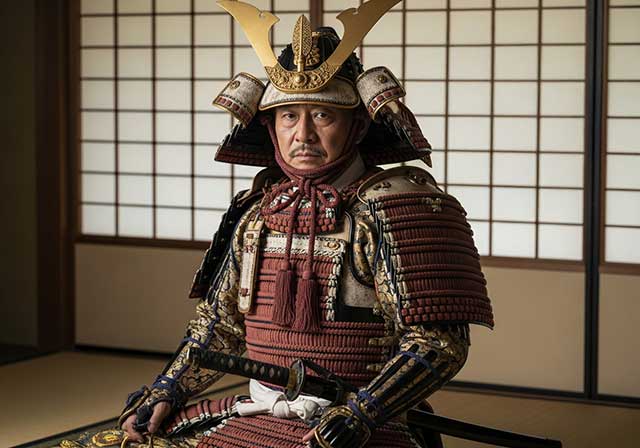
Goto Matabei, also known as Mototsugu, was renowned for his innate combat prowess from the moment of his birth. Hailing from Yamada Village in Harima Province (now a part of Himeji City, Hyogo Prefecture), he stood as a revered professional warrior of the Sengoku period. Matabei proudly bore 53 battle scars across his body, testament to his active involvement in numerous conflicts.
Initially aligned with the Kuroda clan under Kuroda Yoshitaka (Kanbei), he received a stipend of 100 koku until Kanbei's passing in 1604. Thereafter, Matabei served Toyotomi Hideyori at Osaka Castle.
Standing at an imposing height of 180cm, Goto Matabei distinguished himself with his fierce valor during Hideyoshi's Korean Campaigns. He was the first to breach the walls of Jinju Castle during the July 21-27 siege of Jinju in 1593. It's said he ingeniously devised an armored wagon to approach and undermine the fortress walls in Korea. Legends also speak of his solo combat with a tiger that had infiltrated the Japanese camp, claiming a horse's life.
He actively participated in the Battle of Sekigahara under Kuroda Nagamasa, commanding as a captain in the Eastern forces. Engaging in some of the most ferocious combat, Matabei led the Kuroda charge against the Western forces' headquarters on Mt. Sasao. Amidst the chaos, mounted on his steed, Matabei clashed with Ohashi Kanmon, a captain in the Western Forces, ultimately claiming the man's head. Matabei was among the samurai who fought under Tokugawa colors that day but later aligned with Hideyori in Osaka.
Goto Matabei earned a place as one of the "Five Heroes of Osaka Castle." His life met its end in the 1615 Siege of Osaka, specifically during the Battle of Domyo-ji against the numerically superior forces of Date Masamune. Despite awaiting reinforcements, an unusually dense mist delayed their arrival. To hold off the Date forces, Matabei and his men employed swift hit-and-run tactics, launching numerous decisive sorties against the enemy. According to accounts, Matabei personally dispatched some 70 to 80 enemies before succumbing to a musket ball. Unable to stand, he performed seppuku on the field. He was 56 years old.
See also
-
Sakakibara Yasumasa

Yasumasa was the second son of Sakakibara Nagamasa and was born in Ueno in Mikawa Province. From a young age, he began serving Tokugawa Ieyasu and eventually rose to the position of one of his most trusted generals. His wife was the daughter of Osuga Yasutaka. Ieyasu first noticed the young Yasumasa during the suppression of the Ikkō-ikki uprising in Mikawa in 1564. Thanks to his demonstrated abilities, Yasumasa was granted the privilege of using the character “yasu”—the second character of Ieyasu’s own name—in his own. Although he was the second child in his family, he became his father’s heir, though the exact reasons for this remain unknown.
-
Sakai Tadatsugu

Tadatsugu was one of the most renowned generals serving Tokugawa Ieyasu. After Ieyasu broke ties with the Imagawa clan, Tadatsugu—an ardent supporter of this decision—was granted command of Yoshida Castle in 1565, which controlled the coastal road from Tōtomi to Mikawa. During the Battle of Mikatagahara in 1573, he held the right flank of the Tokugawa forces even when the troops sent by Oda fled under the assault of the Takeda army. In the Battle of Nagashino in 1575, he personally requested permission to carry out a night attack on the Takeda camp, which he executed brilliantly together with Kanamori Nagachika.
-
Ryuzoji Takanobu

Takanobu was the eldest son of Ryūzōji Takaie and the great-grandson of Ryūzōji Iekane. His father was killed by a man named Baba Yoritiku in 1544. At a young age, Takanobu took Buddhist vows and received the monastic name Engetsu. However, around the age of eighteen, he returned to secular life, and in 1548, after the death of Ryūzōji Tanehide, he became the head of both branches of the Ryūzōji family.
-
Ouchi Yoshihiro

Ōuchi Yoshihiro was the second son of Ōuchi Hiroyo, who headed the Ōuchi clan in the western part of Honshu. In 1363, Shogun Ashikaga Yoshimitsu confirmed the Ōuchi family in the position of shugo of Suō and Nagato Provinces. In his youth, Yoshihiro assisted his father in strengthening the influence of the Northern Court on the island of Kyushu — they served under Imagawa Ryōsun, who had been tasked with subjugating the nine provinces of Kyushu.
-
Ouchi Yoshioki

Ouchi Yoshioki, the ruler of the provinces of Suo, Nagato, and Iwami, was one of the most capable military commanders and politicians of the late 15th and early 16th centuries. The son of Ouchi Masahiro, he governed from his residence in Yamaguchi in the province of Suo. In 1499, Yoshioki gave refuge to Shogun Ashikaga Yoshitane, who had been driven out of Kyoto by Hosokawa Masamoto. Shogun Yoshizumi, Masamoto’s protégé, ordered the lords of Kyushu to unite their forces against Yoshioki; however, they did not dare to do so, fearing the power of a man who by that time controlled six provinces. Having gathered a substantial army, Yoshioki marched from his native Suo toward Kyoto in order to restore Shogun Yoshitane to power.
-
Otomo Sorin

Ōtomo Yoshishige came from a noble lineage, being the eldest son of Ōtomo Yoshiaki, the ruler of Funai Province. The roots of the Ōtomo family traced back to Fujiwara Hidesato, the adopted son of Nakahara Chikayoshi. Fujiwara served Minamoto Yoritomo during the Genpei War and took part in battles in Mutsu Province in 1189. In 1193, he was appointed shugo of Buzen and Bungo Provinces, after which he adopted a new surname—Ōtomo.
-
Okudaira Sadamasa

Sadamasa was the son of Okudaira Sadayoshi and took part in several battles under Tokugawa Ieyasu, distinguishing himself in the Battle of Anegawa in 1570, where he took two heads. Around 1572 he was forced to enter the service of the Takeda clan, but after the death of Takeda Shingen in 1573 he returned to Tokugawa, leaving Tsukude Castle together with his men. As a result of this defection, Takeda Katsuyori ordered the execution of Sadamasa’s wife and brother, who were being held as hostages.
-
Okubo Tadatika

Tadatika, the son of Okubo Tadayō, entered the service of Tokugawa Ieyasu at the age of eleven, and took his first head in battle when he was sixteen. After the establishment of the Tokugawa shogunate, he was appointed as a rōjū — a senior bakufu official — and was regarded as one of Ieyasu’s most trusted advisors, alongside Honda Masanobu. He is also known for his military chronicle Mikawa Monogatari, which describes Ieyasu’s rise to power and the early years of the Tokugawa shogunate.

